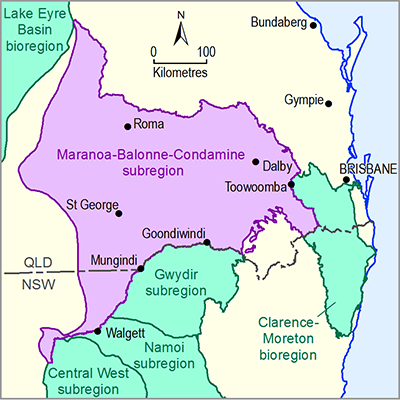Subregions are complex landscapes with a wide range of human and ecological systems. The systems can be discrete, overlapping or integrated. Because of this complexity, a direct analysis of each and every point, or water-dependent asset, in the landscape across the subregion is not possible. Abstraction and a system-level classification was used to manage the challenges of the dimensionality of the task.
A set of landscape classes were defined that are similar in their physical, biological and hydrological characteristics. This reduced the complexity for each subregion and is appropriate for a regional-scale assessment. The landscape classification characterises the landscape and focuses on the key processes, functions and interactions for the individual landscape classes. The landscape classification for the Maranoa-Balonne-Condamine subregion built on existing well-accepted classifications and is described in detail in companion product 2.3 for the Maranoa-Balonne-Condamine subregion (Holland et al., 2016). The landscape classification allowed effort to be focused on those landscape classes that are water dependent.
The assessment of impacts on and risks to water-dependent ecological assets relied heavily on the landscape classification. Potential impacts to individual assets were assessed via their constituent landscape classes. The zone of potential hydrological change was overlain with the extent of the landscape classes to identify those ecosystems and assets that might be subject to hydrological change.

Product Finalisation date
- 3.1 Overview
- 3.2 Methods
- 3.3 Potential hydrological changes
- 3.4 Impacts on and risks to landscape classes
- 3.4.1 Overview
- 3.4.2 Landscape classes that are unlikely to be impacted
- 3.4.3 'Floodplain or lowland riverine (including non-GAB GDEs)' landscape group
- 3.4.4 'GAB GDEs (riverine, springs, floodplain or non-floodplain)' landscape group
- 3.4.5 'Non-floodplain or upland riverine (including non-GAB GDEs)' landscape group
- 3.4.6 'Human-modified' landscape group
- References
- Datasets
- 3.5 Impacts on and risks to water-dependent assets
- 3.6 Commentary for coal resource developments that are not modelled
- 3.7 Conclusion
- Citation
- Acknowledgements
- Contributors to the Technical Programme
- About this technical product
